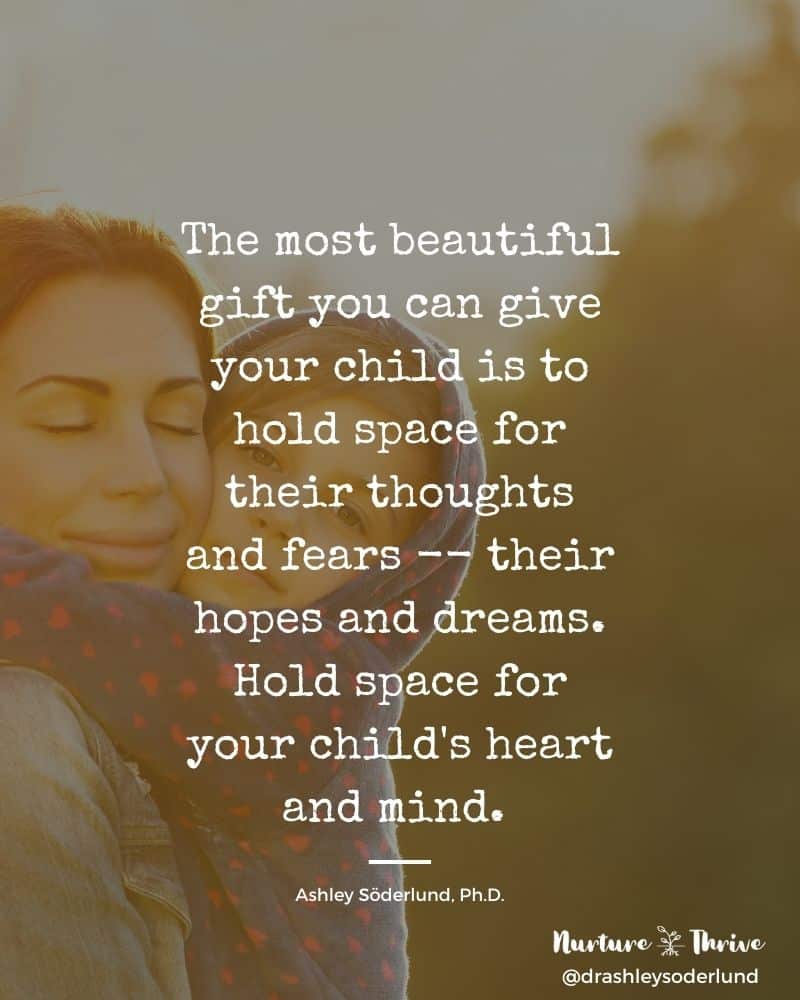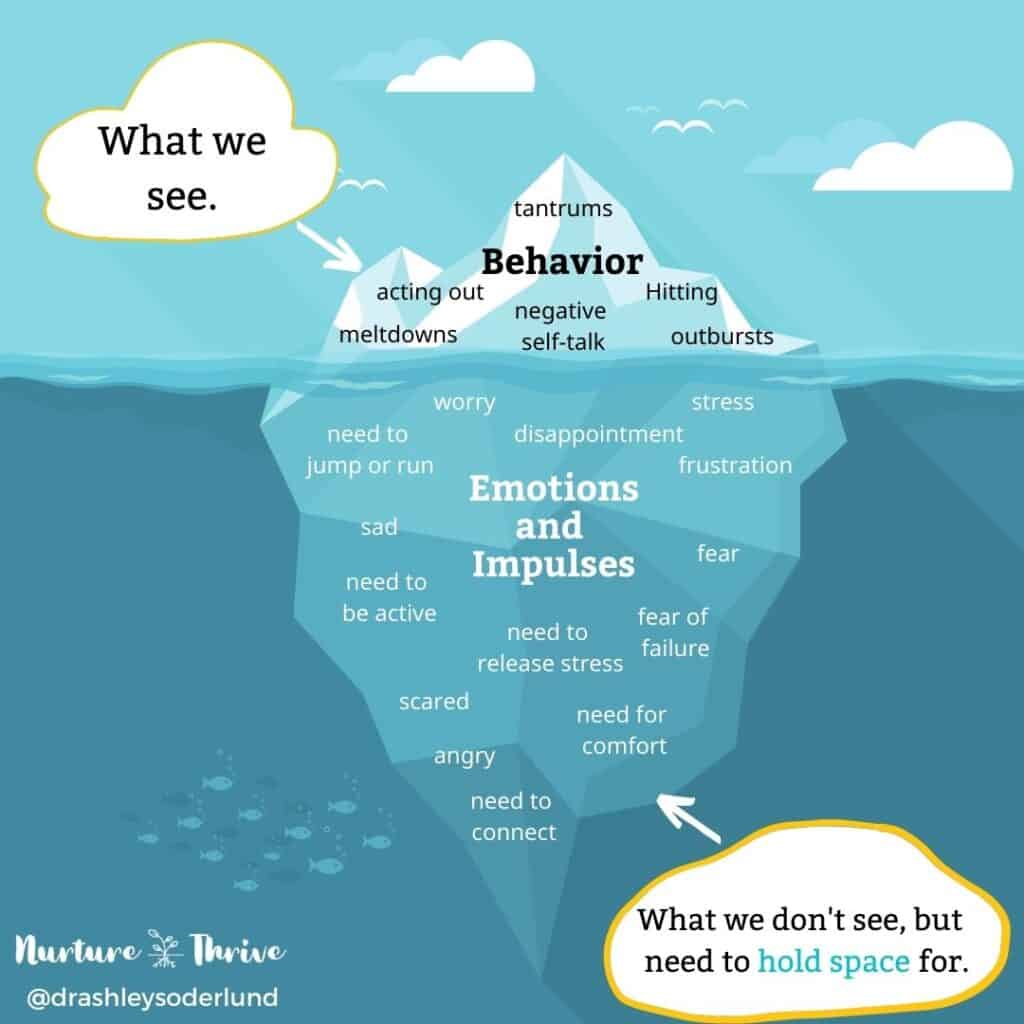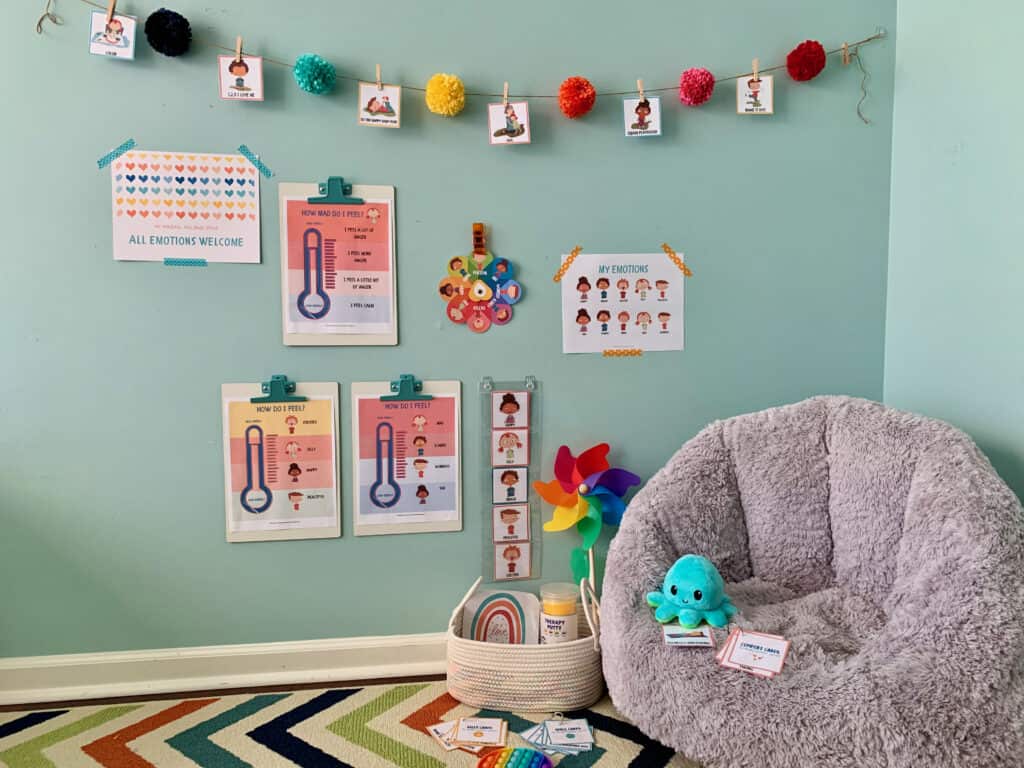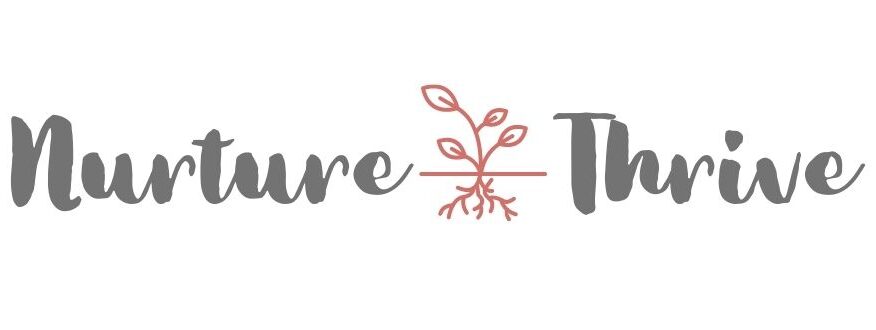Inside: Learn to hold space for your child’s big emotions. Emotion regulation begins with accepting and feeling emotions, not “controlling” them.
When we experience emotions, we try to control them. Most of us try to avoid even the slightest feeling of discomfort. Culturally, we’ve become ingrained with the idea that emotions are irrational parts of ourselves that must be suppressed so that logical thought can prevail.
It is the same when we think about self-regulation or emotion regulation. The first thing that comes to mind is willpower. The idea is that you need to be stronger than your feelings, control them, and suppress them.
Denied, suppressed, and avoided emotions lead to more angst, meltdowns, tantrums, and unwanted behaviors. We can see this in ourselves and our kids.
What if there was a better way?

The answer is deceiving simple, and that is to allow emotions. Welcome them and experience them — to hold space for emotions.
When we allow our kids to feel their emotions, the need for so many “acting-out” behaviors, which are immature attempts to express emotion, fade away.
The Problem with Suppressing and Avoiding Emotions and Impulses
We are often uncomfortable with big emotions. I spent years researching emotions– all the way down to calculating the space between heartbeats and enzymes present in our saliva during periods of stress or distress — and even I catch myself stuffing my emotions deep down inside. Or even worse, dismissing my child’s emotions.
It is so easy to inadvertently teach our kids that emotions should be avoided or dismissed. But what does that teach them long-term?
Suppression of emotions has been solidly linked to:
- Stress
- Poorer immune functioning
- Chronic cardiovascular disease
- Anxiety
- Depression
- Problems communicating in relationships
Suppression of emotion and dysregulation of emotion is especially tied to anxiety and depression in the teen years.
None of this is what we want for our kids.

Four Steps to Hold Space for Your Child’s Big Emotions
Step 1: Separate Emotions from Behavior
The idea that self-control or emotion regulation is simple willpower misses a whole step in the process, an entire component of humanity.
Understanding that humanity can make parenting our kids so much better — it isn’t that our impulses or emotions need to be stopped or even changed. We have to express them in a way that considers other people’s feelings and considers the social cost.
Emotions are not behavior. Emotions are under the behavior, the root of the behavior.
When our kids impulsively act on their emotions, we instantly hone in on what they are doing wrong. We mistakenly equate the behavior to the emotion. This can give our kids the message that how they feel is wrong, making them feel worse and more likely to either internalize or lash out. Over time, this becomes a vicious cycle.
What we need to do is separate the behavior from the emotion. Feeling hurt, frustrated, angry, or upset because your friend took your toy away from you isn’t bad — it is entirely appropriate to feel those things. But the behavior of hitting your friend over the head with another toy isn’t the best way to express those feelings.

Why? Hitting your friend is wrong for many reasons, but one is the social cost –you risk losing that friend. Luckily (and probably due to evolution), little kids don’t hold grudges.
Every day is a new day — a chance to learn what the boundaries of relationships are and how to balance your own needs with empathy for others — in other words, how to love.
Step 2: Recognize That Emotion-Regulation is About Love, Not Will-Power
Flexible and authentic regulation is about love. Love for yourself and for others. Be true to yourself while considering and understanding how your needs and feelings might affect others.
Toddlers and even preschoolers cannot put themselves in someone else’s shoes quite yet. Hence their seemingly anti-social behavior.
And it isn’t that they aren’t capable of love — they love so much and so purely — I love spending time with toddlers just for the joy of pure expression of all that it is to be human.
And that’s what we as parents need to realize. Little kids are human too — perhaps the purest forms of our humanity. Let’s be gentle with that humanity because, as we know from ourselves, it is flawed — sometimes in the best ways.
So often, children are punished for being human. Children are not allowed to have grumpy moods, bad days, disrespectful tones, or bad attitudes, yet we adults have them all the time! We think if we don’t nip it in the bud, it will escalate and we will lose control. Let go of that unfounded fear and give your child permission to be human. We all have days like that. None of us are perfect, and we must stop holding our children to a higher standard of perfection than we can attain ourselves. All of the punishments you could throw at them will not stamp out their humanity, for to err is human, and we all do it sometimes.”
― Rebecca Eanes, The Newbie’s Guide to Positive Parenting
We have this idea that impulse control is all about suppressing the “bad” stuff — the emotions, the impulses — and doing what is “right” and “logical.”
So when we see our kids act out — we think they need more control and more willpower. We feel like we need to control our children’s behavior somehow until they learn what is acceptable. Cue the power struggles.
What is a parent to do? Love and accept your child — even when they are at their worst emotionally.
When your tween slams the door and tells you to leave, they believe they are too upset and flawed to be loved. Show them that you love them. Say — if you want some space, I can do that. I can also stay, even though you have a lot of emotions. I am not scared away — I am okay to sit here and be with you while you feel all of this.
Step 3: Realize That We Can’t Control Our Kids or Their Emotions (and we don’t need to.)
As much as we might like to control our kids and their emotions, the reality is that they are independent beings with a whole set of desires, whims, and emotions — all of which we have no say over.
Instead, we must focus on honoring our child’s impulses and emotions. This helps them learn how to express their feelings and impulses in a way that honors their needs and relationships.
For kids, we are asking them to step outside of their self-centeredness — to put their newfound independence and self-will aside and prioritize other people. That is developmentally really challenging for kids.
But, there is a way we can help to scaffold their burgeoning abilities to regulate and empathize with others … read on for specific examples below.
Step 4: Help Your Child Develop Flexible Emotion-Regulation
An example: Your young toddler is chewing on everything in sight. What do you do? You add a silicon piece to the crib rail, so they chew on that. Or, you take away the dog toy and give them a clean and colorful teether.
You don’t expect them to get rid of the desire to chew. You don’t expect babies not to cry when they are hungry, either. With littles, it is easier to accept the impulse or the emotion.
It isn’t any different for our older kids. As our children grow, the emotions and impulses are less noticeable. We are distracted by the problematic behavior on the surface. If we shift our perspective to look underneath the behavior, we will feel less exasperated and more empathy for that little person trying so hard to communicate genuine emotion.
The impulse and the emotion underneath the behaviors aren’t bad — that you can honor.
The infant cries become the toddler meltdowns, which turn into verbal outbursts in 5- to 8-years-olds, to the tween years of slamming doors, and the stone-walling of the teenage years.
There are endless ways our kids will try to express their hurt, and while you may need to work through some of their behaviors, holding space for how they feel will get you more than halfway there.
Six Real-World Examples of Holding Space for Your Child’s Big Emotions: How to Do It
When your child is “acting out” (which is another way of expressing their impulses or emotions), ask yourself, “How can I help my child express their impulse or emotion in a better way?”
1. Jumping on the sofa = Impulse to Jump
“Hey, remember we don’t jump on the sofa. Let’s go out to the trampoline, or we can put some cushions on the floor and create a jumping obstacle course!”
2. Hitting you = Impulse to get your Immediate Attention/ Connection
“Hmmm, hitting is never okay. It seems like you might want my attention. Is there another way to get my attention?”
3. Running Around at Bedtime = Impulse to release stress or to Connect. “It seems like you need to run around! Let’s all play as silly as you can for 2 minutes! Then it’s brushing teeth, story, and bedtime!”
Related: Five Ways to Reset Bedtime
4. Hitting a friend who grabbed a toy = Feeling Frustration
“Remember, using our hands or feet to show how upset we are is never okay. It seems you are feeling upset. Can you tell me how you feel?” Then, after listening to your child express their feelings, help solve the disagreement. “Let’s see if we can set a timer and take turns.”
5. Time to Go Tantrum = Feeling Big Emotions “I can see that you are upset right now because it is time to go, and you had such fun here. It is time to go, and if you need to cry, I’ll be here with you.”
6. Name Calling or Negative Self-Talk = Fear of Failure/ Making Mistakes/ Disappointment “I can see that this is upsetting you. Are you feeling worried or fearful of making a mistake? It’s okay to feel like that — we all worry about making mistakes. Tell me more about how you feel.”
When you hold space for your child’s emotions, you are helping them build self-love and love for others. You are helping to set the foundation for all of their future relationships.
What you are teaching your child in these situations is that the impulse itself isn’t wrong — the chewing, wanting attention, jumping, frustration, big emotions, fear of failure — those are all valid impulses and emotions! Impulses and emotions that should be heard and expressed.
When you honor your child’s impulses and feelings, you are teaching them:
- What you feel is something to pay attention to. Knowing yourself is important.
- I see you. I see what your need is, and I recognize it as a human need. You need to jump, you need to feel, you need to be angry, you feel big emotions, you are worried about making mistakes — I feel those things too.
- It is important to love yourself and to recognize your needs.
- Relationships are important. We express ourselves in ways that honor our relationships.
- That self-love is important and so is prioritizing other people’s feelings.
These are the building blocks of self-compassion and relationships. Of being able to love and be loved — the greatest need, the greatest emotion, the greatest impulse of all. Honor that impulse.
What to do next…
1. Get advice from Dr. Ashley Soderlund sent right to your inbox. ❤︎
2. Emotional and mental wellness begins at home.
Get the tools you need in my shop! Digital printables you can instantly download and print to foster connection, emotion regulation, and more! Check out the Nurture and Thrive Shop.

Related Resources:
The Most Important Life Skill to Teach Children: Self-Regulation
7 Ways to Turn Power-Struggles and Over-Excitement into Cooperation and Joy
4-Step Guide for Positive Parenting Tweens and Teens: Balancing Responsibility with Connection
Acts of Kindness: Show Your Kids How Doing Good Leads to Happiness
The Heartfelt Way to Deal With Tantrums and Meltdowns: The Two-Step Mindful Emotions System

 Heart-to-Heart Talks: 80 Meaningful Conversation Starters for Kids
Heart-to-Heart Talks: 80 Meaningful Conversation Starters for Kids